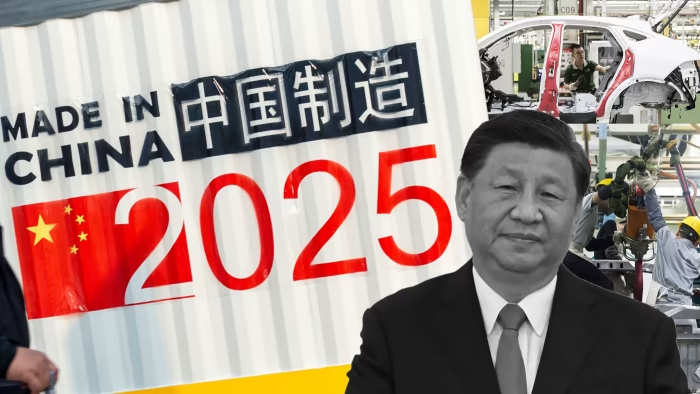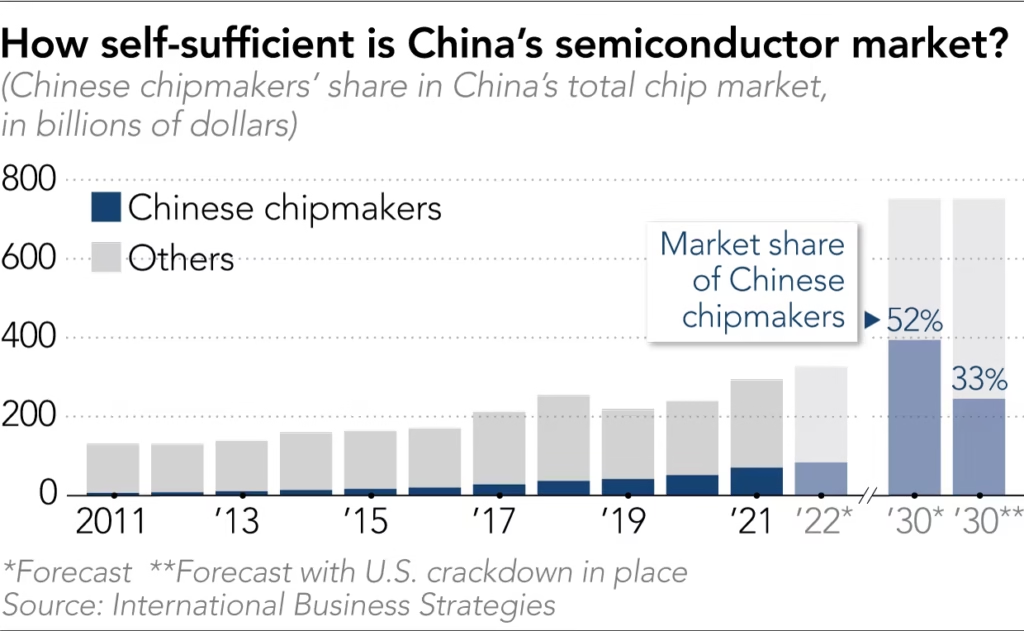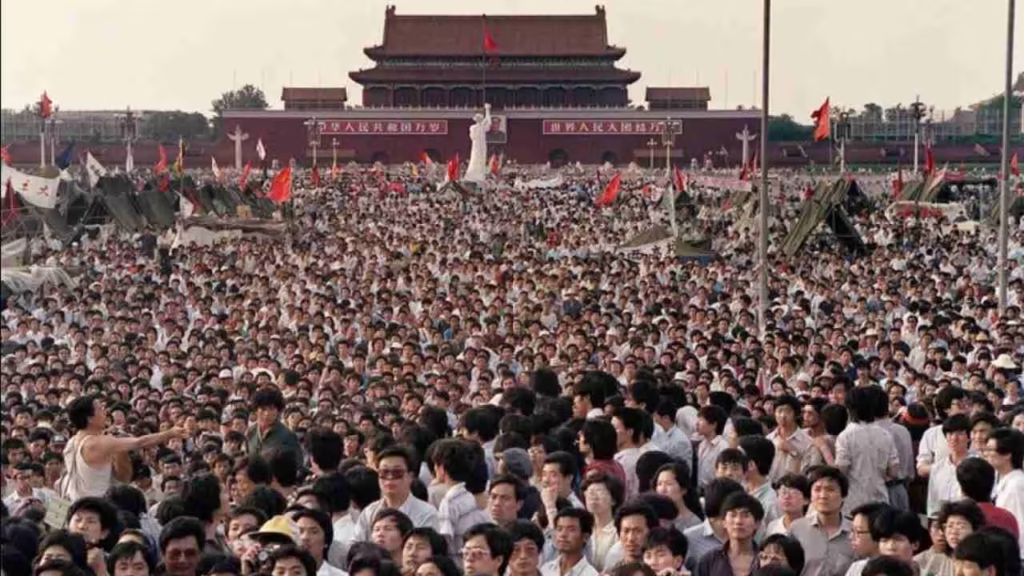The semiconductor industry has become a battlefield in the escalating U.S.-China tech war. With new restrictions, countermeasures, and shifting strategies, the landscape is evolving rapidly.
From China’s ambitious ‘Made in China 2025’ plan to America’s aggressive sanctions targeting companies like YMTC, SMIC, and NVIDIA, the global semiconductor supply chain is at a turning point. As China continues pushing for self-sufficiency, the U.S. is tightening its grip to maintain dominance.
With DeepSeek’s AI breakthrough and Trump’s latest moves, tensions are rising again. So, where does this leave NVIDIA, the world’s leading AI chipmaker? And what’s next for China’s semiconductor ambitions?
Table of Contents

China’s ‘Made in China 2025’ and Push for Semiconductor Independence
1. In 2015, during the National People’s Congress, President Xi Jinping announced the ‘Made in China 2025’ initiative.
2. This plan aimed to invest 1 trillion yuan (approximately $160 billion) into the semiconductor industry, with goals to increase self-sufficiency to 40% by 2020 and 70% by 2025.
3. At the time of the announcement in 2015, China’s semiconductor self-sufficiency rate was around 6%.

4. This means that 94% of semiconductors were imported from other countries.
5. Despite being the world’s largest consumer of semiconductors, China relied heavily on foreign companies like TSMC and Samsung Electronics due to the lack of domestic firms.
China Falls Short of Its Goals
6. By 2020, China aimed for a 40% self-sufficiency rate, but only achieved approximately 16%.

7. In 2020, China consumed semiconductors worth about $140 billion, of which only $22.7 billion were produced domestically.
8. While the target was hugely missed, increasing self-sufficiency from 6% to 16% in five years could be seen as progress.
9. However, a closer look reveals a different story.
10. Of the $22.7 billion produced domestically in 2020, $14.4 billion came from foreign companies’ factories in China, such as TSMC, SK Hynix, and Samsung Electronics.
11. This means that purely Chinese companies accounted for only $8.3 billion, maintaining a self-sufficiency rate of about 6%, indicating little progress.

2025: A Decade After ‘Made in China 2025’ Began
12. The year 2025 has finally arrived—the very year China set as the milestone for its ‘Made in China 2025’ initiative.
13. By the end of 2024, last year, projections suggest that the self-sufficiency rate will be around 19.4%, far below the 70% target set in 2015.
14. This shortfall is largely due to U.S. interventions.

China’s Strategy: Learning From the Display Industry – “Buy, Steal, Abandon”
15. China had modeled its strategy after its success in the display industry.
16. In 1993, employees from the state-owned Beijing Vacuum Electronics Factory founded the Jingdongfang Technology Group.

17. By 2001, this group was merely a subcontractor manufacturing displays for Japanese companies.
18. In 2002, as South Korea’s Hyundai Electronics (now SK Hynix) faced financial difficulties, it sold off non-core businesses.
19. Among these was Hydis, a spin-off from Hyundai’s LCD division.
20. In November 2002, Jingdongfang acquired Hydis for 187 million yuan (approximately $35 million).
21. This acquisition provided them with LCD panel and flat display production lines.

22. Jingdongfang immediately transferred the manufacturing lines and key researchers to China, establishing LCD factories in Beijing and Chengdu by 2006.
23. Once these factories were operational, they abandoned Hydis, leading it into legal management and restructuring.
24. Leveraging Hydis’s technology and personnel, the Chinese factories, supported by low labor costs and government backing, gained price competitiveness and entered the global market.
25. Jingdongfang Technology Group, after acquiring Hydis, evolved into BOE (Beijing Oriental Electronics), now the world’s leading LCD manufacturer.

26. In 2021, BOE supplied OLED panels for the iPhone, challenging companies like Samsung and LG Display.
27. China sought to replicate BOE’s success in the semiconductor sector. (aka. Buy, Steal, Abandon)
China’s ‘Human Wave’ Strategy in Semiconductors
28. China poured state semiconductor funds into YMTC and SMIC, seeking overseas acquisitions to boost its chip industry.
29. The U.S. completely shut down China’s attempts to acquire foreign semiconductor companies.
30. With foreign acquisitions off the table, China focused on growing its domestic semiconductor supply chain.
31. In the semiconductor industry, the most profitable companies are:
- Chip designers (highest profit margins)
- Manufacturers (foundries, moderate profit margins)
- Packaging & assembly companies (lowest profit margins)
32. Since packaging and assembly require a lot of labor, China had a dominant presence in this sector, while U.S. firms like NVIDIA and Intel focused on high-margin areas like chip design and sales.
33. With strong government backing, Chinese packaging firms began moving into chip manufacturing.
34. As China continued advancing, the U.S. tightened restrictions on chip exports.
35. The U.S. banned companies like ASML from selling high-end chipmaking equipment to China.
36. In 2022, the U.S. tightened its policies, blocking exports of any product containing U.S. technology, no matter how small.
37. That same year, the U.S. banned the export of high-performance AI chips to China, citing national security concerns.
38. NVIDIA was hit hard, as it produced the A100, one of the most powerful AI chips.
39. At the time, NVIDIA controlled 90% of China’s AI data center chip market.
40. The world watched closely to see how NVIDIA’s Q3 2022 earnings would be affected.
41. The big question: Would NVIDIA suffer a massive revenue loss?
42. But the earnings report shocked everyone.
43. NVIDIA’s Q3 revenue exceeded expectations.

44. Instead of falling, China’s sales actually grew by 31% year-over-year.
45. NVIDIA did not export the A100 to China due to the ban.
46. Instead, they created a weaker chip, the A800, to comply with U.S. regulations.
47. The A800 had a reduced data transfer speed of 400GB/s, compared to 600GB/s on the A100.
48. Even with the downgrade, Chinese companies optimized the A800 for AI workloads.
49. Meanwhile, NVIDIA’s A100 sales remained strong in Southeast Asia, including Vietnam and Singapore.
50. This helped NVIDIA recover any potential losses from the China ban.

The U.S. Considers Stricter Bans
51. During the Korean War, China used “human wave” tactics, overwhelming enemies with sheer numbers.

52. The strategy was to send poorly trained soldiers first, forcing the enemy to use up ammunition, and then attack with highly trained forces.
53. This tactic worked against South Korean forces, but failed against U.S. troops with superior firepower.
54. Mao Zedong once said, “The lives of the people are lighter than a feather,” and the Chinese military believed, “If the enemy has 100,000 bullets, we’ll send 100,001 soldiers to win.”
55. That’s why out of 920,000 Chinese troops deployed, over 200,000 died.
56. Despite these losses, Chinese troops kept advancing.
57. China is now using a similar ‘MASS production’ approach in semiconductors.
58. When the U.S. banned A100 chips, China bought massive quantities of A800s instead.
59. This helped China bypass the restrictions, keeping its AI industry running while boosting NVIDIA’s revenue.
The U.S. Considers Stricter Bans
60. The U.S. wants to curb China’s semiconductor ambitions but also doesn’t want to harm American companies like NVIDIA.
61. Recent results show that simply restricting chip performance (‘spec-down’ regulations) hasn’t effectively slowed down China’s semiconductor industry.
62. In response, NVIDIA released the H100, a GPU with up to seven times the performance of the A100, in 2020.
63. Just like with the A100, NVIDIA blocked H100 sales to China, only offering a weaker version called the H800.
64. However, China’s DeepSeek claimed that they were still able to achieve high AI performance using the downgraded H800 instead of the more powerful H100.

65. As soon as Trump announced Project Stargate from the White House, China strategically highlighted DeepSeek’s AI advances, likely to provoke a reaction from the U.S. government.

66. The U.S. administration was reportedly furious with China’s response and started preparing additional trade restrictions.
67. On January 29, Bloomberg reported that the Trump administration was considering expanding the scope of semiconductor export bans.
68. This means that the U.S. could soon ban even downgraded chips like the A800 and H800, which were previously allowed.
69. NVIDIA had already anticipated this possibility and prepared alternative products in response.
70. They developed a special China-only version of the RTX50 series, called the RTX5090D, and also introduced the H20, a further downgraded version of the H800.


71. The RTX5090D is 29% weaker than the standard RTX50 and lacks advanced AI inference and computational functions.
72. The key question now is: Will the U.S. allow the export of RTX5090D to China, or will it also be restricted under new regulations?
73. Even the H20, which was specifically designed to comply with current U.S. restrictions, might soon be banned if additional trade restrictions are implemented.
Alphazen Insight

Trump’s reaction to DeepSeek was surprisingly restrained: “DeepSeek’s AI looks faster and much cheaper. This is a wake-up call for American industry to stay laser-focused on competition.”
For someone known for loud, aggressive rhetoric, this calm and calculated remark feels even more ominous. After all, a quiet growl is often more dangerous than a barking dog.
Discover more from Alphazen Dynamics
Subscribe to get the latest posts sent to your email.



